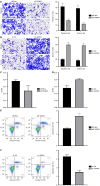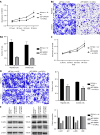Role and mechanism of sarcosine dehydrogenase in the progression of gallbladder cancer through chemokine pathways
- PMID: 40547148
- PMCID: PMC12179943
- DOI: 10.4251/wjgo.v17.i6.105016
Role and mechanism of sarcosine dehydrogenase in the progression of gallbladder cancer through chemokine pathways
Abstract
Background: Sarcosine dehydrogenase (SARDH) and C-X-C motif chemokine ligand 1 (CXCL1) have been identified as potential tumor regulators, with growing evidence linking them to cancer progression. However, their specific roles, regulatory mechanisms, and influence on key signaling pathways remain unclear.
Aim: To investigate the regulatory mechanisms of SARDH and CXCL1 in cancer cells and their impact on key signaling pathways.
Methods: Real-time quantitative polymerase chain reaction and western blot analyses were used to assess the expression levels of SARDH and CXCL1 and their effects on protein kinase B (Akt) and extracellular signal-regulated kinase (ERK) signaling pathways. Gene overexpression was induced using an expression vector, while gene silencing was achieved using short hairpin RNA and small interfering RNA. CCK-8, migration, and invasion assays were used to evaluate the impact of gene suppression and overexpression on cancer cell proliferation, migration, and invasion.
Results: SARDH silencing significantly enhanced cancer cell proliferation, whereas its overexpression suppressed proliferation in the early stages of the experiment. CXCL1 silencing reduced cancer cell migration and invasion. SARDH overexpression inhibited cell migration, invasion, and adhesion while increasing apoptosis. Conversely, SARDH silencing reversed these effects. Furthermore, simultaneous silencing of SARDH and CXCL1 strongly activated the Akt and ERK signaling pathways, indicating the potential role of these pathways in regulating cellular functions influenced by these genes.
Conclusion: This study revealed that SARDH and CXCL1 regulate cancer cell growth, migration, and invasion through Akt and ERK signaling pathways, highlighting their potential as therapeutic targets for cancer treatment.
Keywords: Chemokines; Extracellular signal-regulated kinase; Gallbladder cancer; Protein kinase B; Sarcosine dehydrogenase.
©The Author(s) 2025. Published by Baishideng Publishing Group Inc. All rights reserved.
Conflict of interest statement
Conflict-of-interest statement: All the authors report no relevant conflicts of interest for this article.
Figures






Similar articles
-
tRF-Pro-CGG Suppresses Cell Proliferation and Promotes Apoptosis in Pancreatic Cancer.Dig Dis Sci. 2025 Jun;70(6):2043-2053. doi: 10.1007/s10620-025-08943-x. Epub 2025 Mar 8. Dig Dis Sci. 2025. PMID: 40056302
-
Understanding mechanisms of Polygonatum sibiricum-derived exosome-like nanoparticles against breast cancer through an integrated metabolomics and network pharmacology analysis.Front Chem. 2025 Jun 6;13:1559758. doi: 10.3389/fchem.2025.1559758. eCollection 2025. Front Chem. 2025. PMID: 40547857 Free PMC article.
-
circ-NOLC1 inhibits the development of cervical cancer by regulating miR-330-5p-PALM signaling axis.Hereditas. 2025 Jun 18;162(1):108. doi: 10.1186/s41065-025-00478-5. Hereditas. 2025. PMID: 40533863 Free PMC article.
-
Cost-effectiveness of using prognostic information to select women with breast cancer for adjuvant systemic therapy.Health Technol Assess. 2006 Sep;10(34):iii-iv, ix-xi, 1-204. doi: 10.3310/hta10340. Health Technol Assess. 2006. PMID: 16959170
-
Systemic pharmacological treatments for chronic plaque psoriasis: a network meta-analysis.Cochrane Database Syst Rev. 2021 Apr 19;4(4):CD011535. doi: 10.1002/14651858.CD011535.pub4. Cochrane Database Syst Rev. 2021. Update in: Cochrane Database Syst Rev. 2022 May 23;5:CD011535. doi: 10.1002/14651858.CD011535.pub5. PMID: 33871055 Free PMC article. Updated.
References
-
- Chou J, Quigley DA, Robinson TM, Feng FY, Ashworth A. Transcription-Associated Cyclin-Dependent Kinases as Targets and Biomarkers for Cancer Therapy. Cancer Discov. 2020;10:351–370. - PubMed
-
- Loyer P, Trembley JH. Roles of CDK/Cyclin complexes in transcription and pre-mRNA splicing: Cyclins L and CDK11 at the cross-roads of cell cycle and regulation of gene expression. Semin Cell Dev Biol. 2020;107:36–45. - PubMed
-
- Sun L, Yao X, Liu J, Zhang Y, Hu J. Curcumin Enhances the Efficacy of Docetaxel by Promoting Anti-Tumor Immune Response in Head and Neck Squamous Cell Carcinoma. Cancer Invest. 2023;41:524–533. - PubMed
-
- Cheng Y, Ma XL, Wei YQ, Wei XW. Potential roles and targeted therapy of the CXCLs/CXCR2 axis in cancer and inflammatory diseases. Biochim Biophys Acta Rev Cancer. 2019;1871:289–312. - PubMed
LinkOut - more resources
Full Text Sources
Miscellaneous

